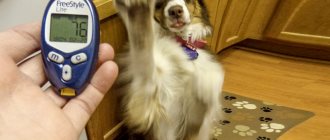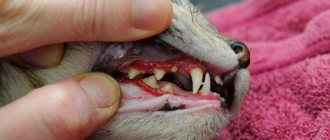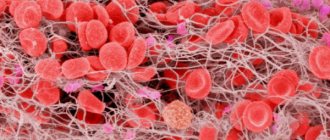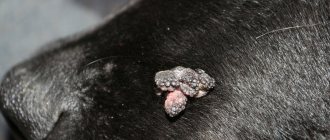What is pathology?
Pathology is an atypical reaction of the immune system, which occurs due to increased sensitivity of the body to certain components. At the same time, the body, for some reason, perceives completely safe substances contained in products as harmful. Then the immune system produces antibodies and begins to fight foreign substances, causing unwanted processes in the body. Signs of an allergy in dogs to food are quite varied; the body can react immediately or after a certain time, upon repeated contact with the allergen.
What to do to eliminate food allergies
It is important to avoid your dog's contact with the allergen. To determine the dog's intolerant substances containing allergens, it is recommended to introduce various foods into the hypoallergenic diet that were previously eliminated.
Each new control product should be added every 7-10 days. After this, it is important to choose a long-term diet. It is better if it is home-cooked food with added minerals, vitamins and essential fatty acids, since various proprietary diets are not so effective.
When choosing a diet for a dog, it is important to remember that the animal needs an additional source of proteins and carbohydrates. If possible, food should not contain preservatives or coloring substances.
Recommended foods containing proteins: rabbit, turkey, chicken, duck. Recommended foods containing carbohydrates: rice, corn. Several diet options are possible.
These photos show what food should be given to dogs with allergy symptoms:
The main causes of allergies in dogs
An allergic reaction manifests itself to any specific ingredient included in the food, and also develops against the background of a monotonous diet. Often these are proteins or complex carbohydrates that are found in cereals, meat and dairy products. The causes of the disease include:
- consumption of low-quality feed;
- mixed nutrition;
- increased protein content in components;
- introduction of new food into the diet.
The nature of the allergic reaction and the severity of the disease depend on the amount of allergen taken and the duration of its use.
Allergenic products
Almost any product or additive in store-bought or natural food can be an allergen. In the case of allergies, everything is very individual. Veterinarians only identify a number of products that most often cause side effects and have formed them into the top 10 highly allergenic products for dogs:
- Chicken allergy ranks number one. Can be found in natural food or dry or wet food.
- Fish and waste from the production of fish products.
- Beef, turkey, horse meat, rabbit, lamb, mutton.
- Dairy and fermented milk products, especially those purchased at the supermarket.
- Yeast;
- Fish fat;
- Fruits - apples, pears, citrus fruits;
- Vegetables - carrots, potatoes, zucchini;
- Soy products;
- Gluten-containing grains.
Chocolate is not included in the list only for the reason that sweets are completely contraindicated for dogs. Sweets have a detrimental effect on a dog’s digestion and the functioning of the cardiovascular system. Don't give dogs sweets!
The owner who suspects a food allergy in his dog should immediately exclude these foods from the diet first. If this does not help, you need to carry out an elimination diet, which will help identify and eliminate the provoking component. This system does not always work, in which case it is necessary to carry out diagnostics in a veterinary clinic.
Some of these products may be included in store-bought feed. Even super-premium-class feed contains waste from meat and food production. The pet owner needs to inquire about the composition of the dog food before purchasing; if it contains suspicious components, then it is not worth buying such food.
Read The best anti-allergy injections and tablets for dogs
Symptoms and signs of food allergies in dogs
Allergies to food in dogs include various symptoms: skin reactions, gastrointestinal disorders, changes in the animal's behavior. The most common signs of the disease are as follows:
- Skin: itching, rash, redness, baldness of the affected areas, dry and scaly skin. The appearance of crusts, wetting of the armpits and chest. The most commonly affected areas are the ears, muzzle, skin folds, inner thighs and abdomen.
- Mucous membranes: hyperemia and swelling of the mucous membranes, lacrimation, nasal discharge.
- Gastrointestinal tract: diarrhea, constipation, vomiting, nausea, flatulence and putrid odor from the mouth.
- Others: otitis externa, ear infections, conjunctivitis.
- Behavior: frequent scratching of the affected areas, shaking of the ears, lethargy, apathy, refusal to eat.
- Rare: convulsions, anaphylactic shock, weight loss (due to diarrhea).
Additional Information:
Symptoms of the disease in dogs are more pronounced and severe than in cats or other species, and the amount of provoking substances is much greater.
Allergy symptoms
In dogs, allergic reactions to food are pronounced, they are easy to distinguish from the harbingers of other diseases.
Main features:
severe skin itching - the pet constantly itches, eczema, redness, and rashes appear;- discharge from the ears, eyes, nose (purulent, serous, watery), over time otitis media or conjunctivitis occurs;
- digestive system disorders: vomiting, diarrhea;
- strong unpleasant odor from wool.
Such reactions are difficult not to notice; in dogs they manifest themselves acutely. The condition of the animal depends on the breed and immunity.
How to distinguish allergies from intolerances
Food intolerance is a condition similar to allergies, but in this case it is not caused by changes in the immune system. This is a problem associated with the body's inability to absorb certain foods or their components without the participation of skin reactions. This may occur for a number of reasons:
- lactose intolerance;
- gluten sensitivity;
- reaction to toxins (food poisoning);
- irritable bowel syndrome.
Important!
Since identical symptoms may indicate other pathologies, it is important not to self-medicate and take your pet to a veterinarian.
Food intolerance may not appear for some time, gradually developing and intensifying. Symptoms of intolerance are: diarrhea, nausea, vomiting and flatulence. To diagnose it, the veterinarian prescribes a blood test for nonspecific immunoglobulins.
Treatment
An allergic dog will have to be fed the selected diet for life. All allergenic foods are excluded, otherwise the symptoms will return again.
Review of Allergy Medicines in Dogs
During the period of exacerbation, symptoms are relieved with drugs (activated carbon, Enterosgel) that remove allergens from the body. Medicines are prescribed that activate the drainage functions of internal organs (kidneys, liver). Oil “Tykveol” improves immunity, protects the liver, and promotes the elimination of harmful substances. Drink the drug for 3-5 weeks.
In the acute form, hormonal drugs such as glucocorticoids (Dexafort, Dexamethasone) and antihistamines (Suprastin, Claritin) are prescribed.
Treatment is carried out according to generally accepted criteria:
- using a hypoallergenic diet;
- exclusion of vitamins, dietary supplements, treats.
The medications are symptomatic; antipruritics are prescribed to prevent scratching. Systemic, antifungal, antibiotics to relieve secondary complications from bacterial infection. During diet therapy, antihistamines and glucocorticoid hormones are excluded, so it is possible to exclude recovery from medications, and not from a new diet.
It is unacceptable to choose a method of treatment or food for allergenic dogs on your own; this should be done by a veterinarian after an examination. It is impossible to achieve the result of therapy only by extinguishing the symptoms of the disease, then relapse is inevitable.
What foods can cause an allergic reaction?
Some types of meat, eggs and dairy products are considered the most common of those that can cause pathology. In addition, other ingredients can cause illness:
- beef;
- chicken;
- lamb;
- pork;
- fish;
- wheat;
- soy;
- corn;
- dairy products;
- eggs.
The most common foods that cause allergic reactions are beef (37%) and chicken (15%), as well as dairy products (17%).
Allergy - what is it
An allergic reaction is an aggravated immune response to certain substances that enter the body .
The inflammatory reaction occurs with the release of histamine into the blood. This substance causes redness, rash, itching, and swelling.
Chemicals or products are not always the trigger. In some cases, the animal has a congenital, hereditary, genetic predisposition to such reactions.
Veterinarian's actions
To establish a diagnosis in the clinic, I prescribe a series of studies for the animal, which must be carried out comprehensively in order to exclude other possible causes. For example, when infected with scabies mites or fleas, the same clinical signs appear as with food allergies, which do not disappear with a change in diet. Therefore, the pet is prescribed blood donation, skin scrapings, stool analysis for helminths, bacterial cultures, etc.
When diagnosing, it is important to determine what type of protein the pet is developing hypersensitivity to. The most effective way is considered to be an elimination diet followed by provocation. From the animal’s diet, first of all, exclude those components that the pet has recently consumed. The method involves the following steps:
- The animal is given food containing a new source of protein that was not previously present in the diet.
- If the symptoms have disappeared, a provocation is carried out. To do this, the previous foods are introduced into the dog’s diet.
- If clinical signs reappear, the diagnosis is confirmed.
Additional Information:
if the clinical picture has not changed during the study, this indicates the presence of a non-food allergy. In addition, if the itching does not completely disappear and intensifies after a challenge diet, the animal may have both forms of the disease.
The elimination diet is carried out for 6-10 weeks. All this time, you should strictly adhere to all restrictions and other doctor’s instructions. The pet is prescribed general and local antihistamines, which will alleviate the condition and speed up the recovery process. In the presence of secondary diseases (otitis, conjunctivitis, pyoderma), drugs are prescribed to treat them.
Diagnosis of the disease
Modern veterinary medicine does not have laboratory methods for detecting food allergies to a specific substance. Doctors can diagnose allergies but not identify the allergen. At the same time, diagnosis is necessary, because the symptoms of allergic reactions are very similar to other diseases. If the diagnosis is confirmed by scraping or blood and urine tests, doctors most often prescribe diagnosis using the elimination diet method. The process is lengthy and is carried out at home.
Elimination diet
A diagnostic diet is administered by a veterinarian to identify and exclude the allergen from the animal’s menu. For the normal functioning of your pet’s body, you need healthy ingredients that are found in different products, so eliminating “everything” will not work.
In the first 5-7 days, a diet is prescribed with the exclusion of chicken and meat of other birds from the diet. Next comes monitoring the condition of the animal. If there is no result, chicken meat is returned to the diet, other types of meat are excluded and observed again. So the animal’s diet is changed until the food allergy stops.
When it was noticed that the adverse reactions stopped or began to decrease, the last menu is left for another week. If the manifestations have completely disappeared, the reverse process of diagnostic nutrition begins. Feeding begins to gradually include foods that could cause allergies, according to the same principle as before.
When the owner has identified a suspected allergen, you need to take the dog to the clinic and carry out an allergic provocation under the supervision of doctors. The dog is given a product to eat that the owner considers a provocateur of the disease. If signs of the disease return, the doctor makes a specific and final diagnosis.
Foods to be given during treatment
If the diagnosis is established, the veterinarian selects a special diet, including hypoallergenic food and complete avoidance of foods that may contain an allergen. Preference is given to brands with a new composition, in which the protein source can be duck, lamb and salmon. Holistic products are a good choice: they do not contain soy, corn and other highly allergenic ingredients. Various manufacturers offer a choice of:
- with hydrolyzed protein;
- monoprotein;
- grain-free;
- containing no animal protein.
When introducing a new food, it is important to carefully monitor the animal’s reaction in order to promptly detect undesirable changes.
The main “culprits” of food allergies
The main cause of true food allergies in dogs and cats are proteins, and their mass should be more than 10 kDa; the heavier the protein, the greater the chance that the immune system will “dislike” it. That is why the most common culprits in the development of allergies in dogs are the proteins of beef, dairy products, chicken and wheat gluten, and in cats: milk, beef, fish and chicken. This doesn't mean your dog can't develop a food allergy to, say, turkey, but it's much less likely to happen. There is a lot of good research in humane medicine about what factors predispose people to developing food allergies. For example, the role of dysbiosis and concomitant inflammatory bowel diseases has been proven. There are practically no such studies in dogs, but it is clear that dogs that have had parvovirus gastroenteritis are more susceptible to developing food allergies in the future. So, what foods are the most common for dogs to develop food allergies? (research data for 2021):
- Beef
- Dairy (even fermented milk) products
- Chicken
- Wheat (less often other grains) gluten
Food for dogs with food allergies
For pets with this pathology, it is important to choose high-quality industrial dry hypoallergenic food that does not contain food industry waste, harmful additives, dyes and flavors. The list of brands recommended by veterinarians is as follows:
- Proseries Holistic;
- “Fi;
- "Farmina";
- Royal Canin.
Important!
The animal's diet should contain easily digestible meats, as well as all the vitamins, minerals, and omega fatty acids the animal needs.
How to self-diagnose food allergies?
To determine the presence of a food allergy, and not another type of disease, you need to take the following measures:
- If the animal begins to suffer from the above symptoms, and the owner assumes that this is an allergic reaction to a certain type of food, you should start feeding the dog food (natural or expensive hypoallergenic dry food) that it has not eaten before.
- The dog should receive this diet for at least two or even three months. When your pet's health returns to normal, you can return to your normal diet. If symptoms recur, it will become clear that the dog is experiencing an allergic reaction to certain components of its usual diet.
- Quite often such testing has to be carried out with a different set of products until a specific allergen is identified. Despite the complexity and duration of such testing, this is the surest way to rid an animal of food allergies.
Diagnostics
When diagnosing an allergy, it is first important to exclude other diseases with similar symptoms. Such diseases can be: scabies, parasites, fungal infections, and so on.
You should bring your pet to a veterinary clinic, where a veterinarian-allergist will conduct an external examination of the animal, take tests, scrapings and smears.
Elimination diet
An elimination diet allows you to determine whether you have a food allergy, and if so, to what foods.
First, the pet is switched to foods different from those that it usually eats. However, simply changing the food is usually not enough, since the food may consist of the same components.
Read Causes of alopecia in Spitz: effective ways to eliminate the problem
First, you need to make a list of the foods your dog eats and study the composition of the food.
Then select products of similar nutritional value from a different origin. It is advisable that the dog has never eaten them before. For example, chicken meat can be replaced with duck meat. There are also special dietary foods for such cases.
It is better to consult a veterinarian or allergist about the set of products for a new diet.
After such a radical change in diet, the allergy usually goes away within a few weeks if it is of a food nature.
The next stage of this diagnostic method is to provoke allergies by gradually returning old foods to the diet. In this way, it is possible to determine which product or substance an allergic reaction occurs to.
Laboratory research
If an allergy is suspected, the following laboratory tests are performed:
- Serological test: allows you to study antigens and antibodies in the blood;
- Allergy test: A possible allergen (or set of allergens) is injected into the top layer of the skin, after which the veterinarian observes the reaction. Used to identify non-food allergies.
Most common symptoms
Let's discuss the most common clinical signs (symptoms) of food allergies in dogs.
As a rule, these are young dogs (up to a year old) or middle-aged and older dogs (6 years and older). Even predisposed breeds have been identified: German Shepherds, West Highland White Terriers, Boxers, Rhodesian Ridgebacks, Pugs. How do food allergies manifest in dogs? The disease can have both skin lesions and disorders of the gastrointestinal tract (chronic vomiting and diarrhea). The main and most noticeable acute skin symptoms of food allergies in dogs are presented in the photo.
At the beginning, they include itching and self-injury (scratching), then bacteria settle on the inflamed and injured skin, which can cause more serious problems, for example, purulent inflammation of varying severity (from superficial “pimples” to deep boils), and of course inflammation of the ears (otitis media). By the way, otitis media, including those that have been occurring for a long time, can be a symptom of a food allergy, even if the dog otherwise feels well.
Rice. 1 and 2. Acute and chronic food allergies in dogs
If the disease develops for a long time, then you can observe thickening of the skin, especially in the armpits, groin and under the tail, inflammation of the skin between the fingers, severe purulent inflammation of the skin and ears, and weight loss. You can see what the symptoms of chronic food allergies look like in the photo.
Fig 3,4,5. Manifestations of food allergies in dogs: Malassezia dermatitis, microbial otitis media, bacterial folliculitis.
What to do if you suspect your dog has a food allergy?
Of course, first of all, you need to contact a veterinary dermatologist. But, if for some reason this cannot be done right now, then we will discuss the main aspects of the treatment and diagnosis of food allergies in dogs. The primary task is to relieve the dog of itching, which can manifest itself to varying degrees individually. Often, the owner is faced with such severe food allergies in the dog that the dog cannot sleep at night and is constantly itching. In this case, an affordable and fast-acting drug that relieves itching is needed, and it is also very important that it is well tolerated by the dog’s body. Apoquel®, an original drug that specifically targets the mechanisms of development of itching, meets all these requirements. Apoquel quickly (within several hours) eliminates discomfort associated with itching, redness, scratching and swelling. The drug is recommended for long-term use; in the first 2 weeks it is important to give it to the dog 2 times a day, then switch to once a day. A convenient table for calculating dosage by dog's weight is included in the instructions. The therapeutic effect of the drug in the fight against itching has been confirmed by many years of experience in use by domestic and foreign veterinarians; several hundred articles have been written about its use in the treatment of allergic dermatitis in dogs. The drug does not cause addiction or “withdrawal syndrome”, and is also approved for use with other systemic drugs, for example, tablets for helminths, fleas and ticks (does not cause a decrease in their effectiveness). It is important, however, to remember that you should not use Apoquel on your own in dogs under one year old, weighing less than 3 kg, lactating, pregnant females, dogs during the mating period and those with tumor diseases. Consultation with your veterinarian is recommended before using any drug. In addition, if there are symptoms other than itching: pododermatitis, bacterial skin diseases, otitis, additional diagnostics and therapy are recommended. In this case, medications to treat food allergies will include antibacterial shampoos, ear drops, fatty acids, and possibly systemic antibiotics. It is worth recalling that self-prescription of antibiotics in any form (drops in the ears, ointments, tablets, injections) is strongly not recommended and can lead to a worsening or distortion of the situation, as well as cause undesirable effects (vomiting, diarrhea, drug reactions, bacterial resistance).
In addition to relieving itching and inflammation in the case of food allergies, it is important to understand what product is causing it. In order to find out, it is necessary to resort to the “gold standard of diagnosis”, namely the elimination diet. Unfortunately, blood testing for food allergens in animals has not found practical use and is not recommended by leading veterinary allergists as a diagnostic technique. For a correctly implemented diet, you should use food with a new source of protein, so simply changing the diet to a line “for sensitive skin” is not enough. The ideal option would be for a veterinarian to prescribe a diet based on the feeding history, because it is very important not to prescribe protein sources that the dog ate less than 4 months ago, and it is also important to take into account one very interesting feature - protein cross-reaction. This phenomenon was described relatively recently and concerns the meat of closely related animal species. For example, if your dog is exhibiting symptoms of a food allergy, presumably to beef, then prescribing lamb, buffalo, goat, deer, or elk as an exclusion diet would be inappropriate, since these animals are genetically similar and the immune system is also most likely to react to their meat. Choose meat from completely different types of animals for your diet, for example, if your dog has been eating chicken for a long time, then it is better to choose pork or fish as a diet. The source of carbohydrates also plays an important role - it is better not to choose food containing gluten, and stick to vegetables as a side dish. You can use commercial mono-protein foods with selected ingredients, or you can balance your dog’s natural diet with the help of a veterinarian with knowledge of nutrition. A good plan is to use hydrolyzed diets. Their meaning is that the protein molecules in their composition are broken into small pieces, the molecular weight of which simply will not allow the allergy process to develop; also, usually, proteins that are unusual for our dogs (soybeans, feathers) are used as part of such diets, but this should not scare you, because the formulation of industrial feed is always balanced in vitamins, macro- and microelements.
So, for diagnosis, and, consequently, for the treatment of food allergies in dogs, you can use three diet options:
- Mono-protein industrial diet (preferably without grains)
- Mono-protein diet prepared at home (side dish - vegetables) after consultation with a nutritionist
- Hydrolyzed industrial diet
Nutritionists advise switching to new foods gradually, over 5 days, to avoid negative intestinal symptoms. Although, even if they do occur, they go away without treatment within a few days. The question of the duration of an elimination diet was quite acute some time ago; now we recommend an average of 8 weeks to adhere to a new diet in order to evaluate its effectiveness. When switching to a diet for a dog to treat symptoms of food allergies, Apoquel can be prescribed for a period of 14 to 21 days; taking the drug will not affect the duration of the diet and will not reduce its diagnostic value. You can also add fatty acids to your diet in the form of salmon oil, which is sold in pet stores, it will improve the condition of the skin and additionally help relieve inflammation.
In order for the diagnosis of food allergies to be as effective as possible, it is important for the dog owner to take into account certain aspects, namely:
- Understand the importance of diagnosis (after all, this is the only way a veterinarian can make a diagnosis), and really stick to a strict diet
- Eliminate all “unexpected” protein intake from the dog’s diet (vitamins, “snacks”, treats, including from the table, preparations with meat flavors)
- Keeping in touch with your veterinarian is very important if something in the diagnosis does not go as expected
The diagnosis of “true food allergy” is considered established if there was a marked improvement in the health status during feeding with an exclusion diet, and when provoked by a previous food, the situation worsened again. Provocation is very important, since the symptoms of food allergies are exactly the same as, for example, seasonal ones. If there is no deterioration within an average of 14 days after returning to normal food, the diagnosis of “true food allergy” is considered excluded. Of course, partial improvement is possible while using the diet, that is, the symptoms of food allergies have disappeared, but not completely. In this case, your dog probably also suffers from an underlying allergy, such as atopic dermatitis or hypersensitivity to flea saliva. In this case, as in the case of the impossibility of carrying out an elimination diet (sometimes dogs refuse to eat new food, the owner’s personal circumstances may not allow diagnosis), the question of how to long-term treat food allergies in such a dog without harm to the body can be discussed. There are many medications available for long-term itching control in the form of tablets, capsules, and sprays. The doctor will decide which drug to prescribe for your dog, based on its individual characteristics. In most cases, Apoquel will be the drug of choice, as it controls allergy symptoms well, is approved for long-term use and is well tolerated by the dog.











